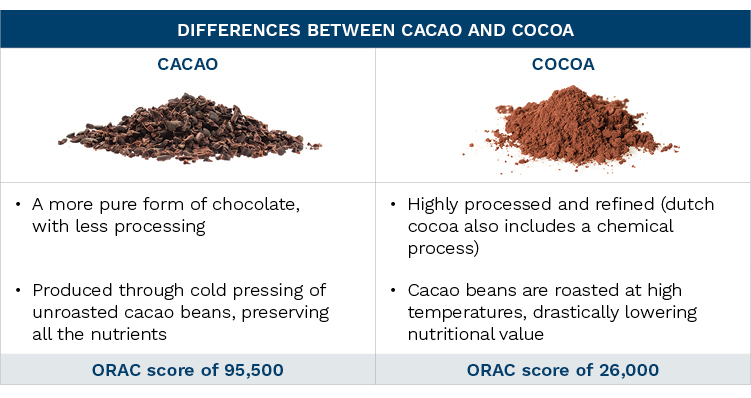Let me be clear – not all chocolate is good for you, but raw, unrefined cacao has so many health benefits that it should be a regular addition to your daily diet (provided it is good quality without added sugar, chemicals or preservatives!).
What is the difference between cacao and cocoa?
Cacao and cocoa are both produced by harvesting the cacao beans that are found inside seed pods, grown on the cacao tree (Theobroma cacao). These trees are typically grown in tropical environments and are native to Central and South America and parts of Africa. According to Mayan mythology, cacao was discovered by a ‘Cacao God’ and was often offered as a gift to deities and used in celebrations. In ancient Mexico, it was a luxury drink only enjoyed by the rich and privileged, and was even used as a form of money.
Raw cacao powder and nibs are produced by fermenting, grinding, then cold pressing raw cacao beans (this means that the temperature must never exceed 47 degrees celsius). This process ensures that the living enzymes, antioxidants, vitamins and minerals are all preserved and only the fat (cacao butter) is removed.
Cocoa looks similar to cacao, however is quite drastically different in its medicinal properties and its processing. Cocoa powder is produced by first roasting the fermented cacao beans at a high heat, then grinding the roasted beans into cocoa mass which is then pressed to remove the cocoa butter. The remaining cocoa is then ground into a fine powder.
Dutch processed cocoa powder is even further treated early on in the process with an alkalised chemical solution, which gives the end product a richer, less acidic taste, but removes even more of the nutrients.
Cacao and cocoa have been measured on the ORAC scale (this stands for oxygen radical absorbance capacity) which is a way of measuring antioxidant levels. Raw cacao powder has an ORAC score of 95,500, whereas roasted cocoa powder only has a score of 26,000. That’s nearly four times the amount of antioxidants!
Cacao is thought to be the highest source of antioxidants of all food, containing more per 100g than acai berries, goji berries and blueberries - comparatively, the ORAC score of blueberries is only 4,669. These antioxidants, containing 2 different types of flavonoids make up around 10% of the raw cacao powder.
Antioxidants neutralise free radicals, help to prevent ageing, prevents the oxidation of LDL cholesterol (bad cholesterol) in the blood and reduces inflammation in the body. Cacao also improves insulin sensitivity and contains thermogenic proteins which help with weight loss by raising your rate of metabolism.
Cacao contains high levels of serotonin, dopamine (the happy hormones) and anandamide (which is normally created by our bodies when we exercise). The combination of these chemicals makes us feel happy, relaxed and reduces stress, which explains why chocolate is so addictive!
Other compounds found in raw cacao include high levels of magnesium, as well as resveratrol, iron, sulphur, potassium, calcium, zinc, copper and manganese.
Factors that may affect the antioxidant activity of raw cacao
Interestingly, research shows that dairy products can actually inhibit the absorption of antioxidants from raw cacao, so it’s much better consumed alone or with dairy free milk such as coconut, rice, almond or oat milk.
While adding heat (such as hot water or cooking in an oven) will destroy some of the benefits of raw cacao, it will still be far more beneficial to your health than standard cocoa powder or Dutch processed cocoa powder. It’s good to remember that minerals are rarely damaged by heat, so it is only the antioxidant activity that may be compromised.
